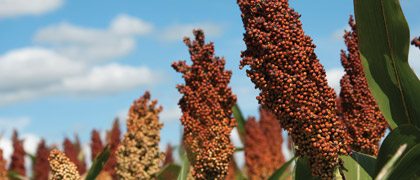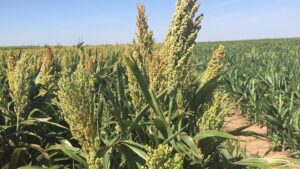More and more acres in the United States and around the world are being planted with this hardy, drought-resistant grain. The growing number of uses for sorghum is a big reason why.
Sorghum is one of the most versatile crops around and has a growing list of uses. This hardy, drought-resistant grain has commonly been used as livestock feed, but is now carving more space in the biofuel market. It can serve as a feedstock in ethanol production, as well as a biomass crop to help fuel power plants. But sorghum is also used to make such things as gluten-free bread and fiberboard, and is a key ingredient in many Chinese wines.
According to Tim Lust, CEO of the National Sorghum Producers (NSP), these are boom times for the sorghum industry. NSP is a trade organization focusing on legislative and regulatory activities affecting the American sorghum industry.
Lust says the number of acres planted for the three main types of sorghum — grain, forage and silage — are growing. NSP estimates nearly 100 million acres of grain sorghum were planted around the world in 2013, with U.S. grain sorghum acreage tipping 8 million acres. For the U.S., that’s a 35 percent increase from 2012, and the prospects for 2014 are even better. “Most of the private analysts say we will be up another half a million acres this year,” Lust says.
Some of these acres will produce sorghum seed earmarked for export markets. “Mexico has always been a very strong market for the U.S. sorghum seed industry,” Lust says, listing China and Ukraine as two other main seed buyers. “Ukraine has been a significant increase for us globally on the seed and genetic sides. With the unrest there, we’re a bit concerned as that has been a very strong market.”
China is a growing market and there is increased demand not only for U.S. grain sorghum but also sorghum seed, Lust says, adding that certified seed is an important component of the sorghum seed trade, both domestically and internationally.
Water Efficiency Drives Demand
The demand for sorghum doesn’t just stem from an increase in the number of end uses, but Lust attributes sorghum’s global growth for its durability in varying environmental conditions. “The ability of sorghum to do well with less water is a huge driver,” Lust says. “It is a good fit in many different geographic areas — it’s capable of being grown on about 80 percent of the world’s land.”
However, as demand for sorghum and its various end uses continues to increase, the industry anticipates further growth in terms of investment in the crop from private companies. Lust says the industry has already seen a substantial increase in private investment in recent years, which has fueled sorghum research and development, particularly in genetics.
“Genetic improvement has been a major priority and an area where we needed investment,” Lust adds. “We went through a period when we didn’t have much private industry investment. We need that investment, to remain competitive and take advantage of all the genetic potential that is in the crop.”
End-Use Segmentation on the Rise
Much of this investment flows from large corporations that dominate the U.S. sorghum industry, according to Tracy Talley, owner of Texas-based Justin Seeds, which sells some forage sorghum seed products. He maintains consolidation in the sorghum marketplace has contributed to increased end-use segmentation.
“There are just a handful of companies that are doing the breeding work, and in the public sector that breeding work has fallen off in the past decade,” Tally says. “The only people coming in to fill that gap are a few larger companies. This consolidation has increased segmentation throughout the industry.”
Lust agrees that like corn, the sorghum market will continue to see strong end-use segmentation, which will influence the direction of future seed development and breeding efforts.
“Sorghum has tremendous genetic diversity, so a lot of discussions are about what quality traits can we do with sorghum that fit a specific end-use market,” Lust says. “There’s value in different end uses based on different traits. If there’s enough value, you will continue to see that segmentation.”
So what exactly are growers looking for in new sorghum traits? “Anytime surveys are done, yield is No. 1,” Lust says, adding that things like herbicide resistance are also always on growers’ minds. Talley says enhanced drought tolerance is another sought-after trait, particularly in the primary sorghum-producing areas.
Some traits, though, are often tightly linked to specific end uses. For example, sorghum with higher starch content or “a more fermentable and extractable starch” has real value in the biofuel market, Lust says.
In addition to grain, forage and silage, there are a couple of sorghum types — biomass and sweet — that are grown on far fewer acres (less than 100,000 for each in the U.S.) but are starting to attract significant interest, and more importantly, investment dollars for research. More dollars equals advances in sorghum breeding and
varietal development.
“Our seed companies have made some really spectacular genetic advancements on sweet and biomass sorghum,” Lust says.
Mark Halsall
Partnering to Improve SorghumMost recently, DuPont Pioneer and the United Sorghum Checkoff Program announced a collaboration to advance genetic tools and opportunities for grain sorghum. Under a three-year collaboration agreement, the Sorghum Checkoff will leverage the seed technology program at Pioneer for a total investment of $800,220. |













